Well, it's tomato planting time here at the Crossroads, and we thought we'd pass along a few of our tips about planting tomatoes. Leo and I are not experts by any means, but we have been gardening for a few years now and we have learned a few things along the way. Growing great tomatoes doesn't just happen, and we're glad to share what has worked for us.
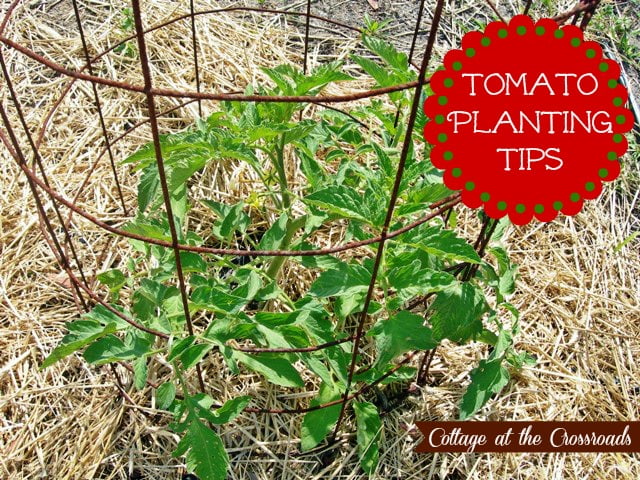
First, you must select a nice sunny area to grow your tomatoes because they need at least 7 hours of sunlight. The next thing is that you must prepare your soil. This area has had a layer of leaves sitting on it this winter, and Leo tilled them under in January. See those black piles sitting on the ground? That's a mixture of our homegrown compost and a commercial compost called Black Kow.
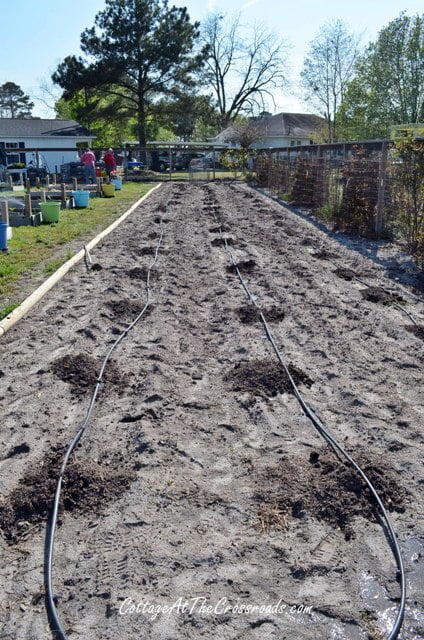
You should have seen the earthworms in our compost scrambling to go underground, and that's a very good thing! These piles of compost sat on the ground for a few days at the places where we were going to dig our holes.
The first year that we started our garden, we just planted our tomatoes into our soil without adding any compost. The plants produced some tomatoes that year but not anywhere near as many as we get since we've been adding compost.
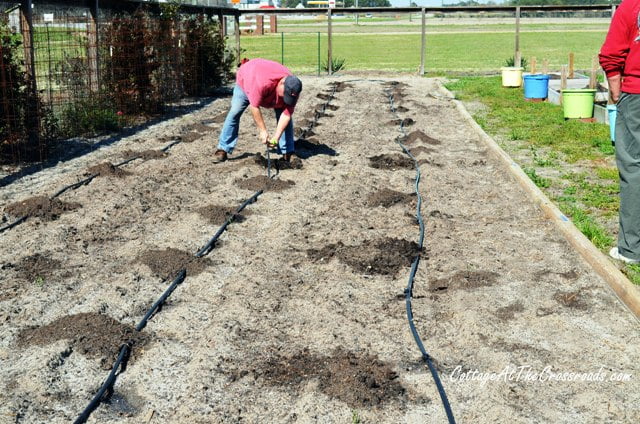
Another tip is that you must water your tomato plants regularly and consistently. Our first year, we had a lot of tomatoes that split open because we didn't understand the importance of consistent water.
When they looked dry, we gave them a whole bunch of water and then we wouldn't water again for a few days. And when we got tired of watering with a hose, we turned on a sprinkler!
At that time we didn't know that watering overhead splashed soil born diseases onto the leaves. Yikes! So in the above photo, Leo and his brother Jim are attaching the drip heads to the irrigation hoses that we've started using in the garden. This system gives the plants water at their roots. You can read more about installing a drip system in Leo's post don't hesitate to irrigate, which turns out is very important.
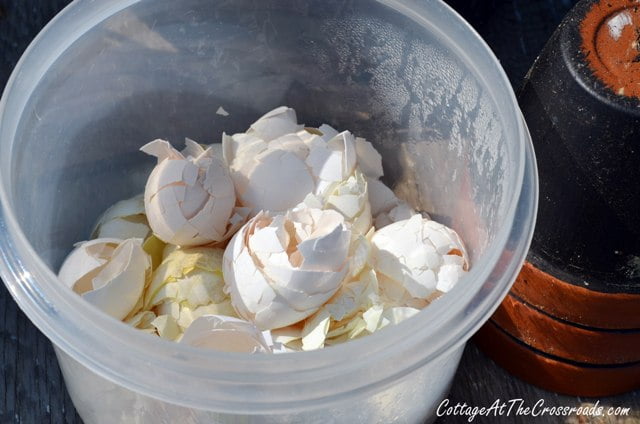
Another tip that I can give you is to add crushed eggshells in your planting hole. We have been adding eggshells all along to our compost, but I started saving some separately for a few months now. The purpose of adding eggshells to the hole is to provide the tomatoes with calcium. The first year we planted tomatoes, we were plagued with blossom end rot. I cannot tell you how many tomatoes we had to throw away that first year because of it. But since we've been using compost with eggshells added to it, we've had no blossom end rot.
As we were digging our holes to plant the tomatoes, the piles of compost got added into the soil, but here's another secret.
Along with the eggshells, we added dead fish. Leo's brother Jim likes to go fishing and he froze some fish just for this purpose. We added fish to our holes last year, and we had more tomatoes than we knew what to do with! The fish supplies additional calcium for the plants. If handling dead fish is not your cup of tea, then you can always add some fertilizer that has trace elements in it.
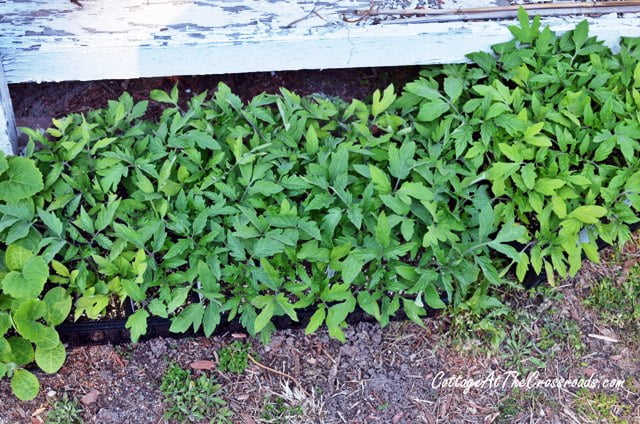
When we plant tomatoes, we use transplants. We are fortunate that we live near J&W Greenhouses where they are grown locally. Here's another tip. Do a little research about what variety of tomatoes you want to grow. This week we planted Celebrity and Better Boys. Both are hybrids that have stood the test of time and are very disease resistant. Planting varieties such as this will ensure that you will get some tomatoes! Next week, we will also plant some heirloom varieties.
It's also important to note what kind of tomato you are planting. Tomatoes are classified into two main groups-indeterminate and determinate. Knowing what kind of plant you have will help you decide how to support the plant once it gets growing.
Here's how I remember it. Indeterminate plants go IN a cage because they will grow tall (up to 6 feet) and will need a strong support system. Leo made our cages using some concrete reinforcing wire. I'll see if I can get him to do a post explaining how to make them.

See those bottom two leaves on the tomato plant?
Snip or pinch off those bottom leaves. The reason that you want to do that is so that you can plant it deeply to encourage new roots to form along the stem. You'll have a much stronger plant if you do.
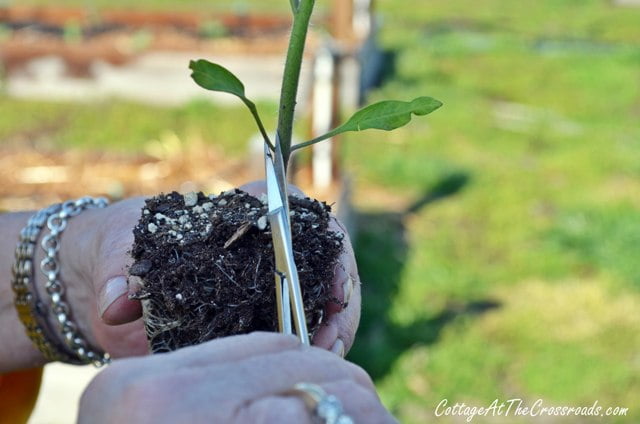
Another thing that you need to remember is to allow plenty of space between each plant. We usually allow about 3 feet. Once you add your tomato cage, you have to have room to walk around it to harvest the tomatoes.
In our first garden, we planted our tomatoes too closely, and I had difficulty getting around the cages without scraping against them. In this photo, you'll notice that we have planted French marigolds between the tomatoes. Their purpose is to protect against nematodes that are in the soil. Now what exactly is a nematode, I do not know, but it isn't good!

We started placing landscaping fabric around our tomatoes last year. Since we plant so many tomatoes, weeding becomes a never-ending and tiresome chore. Last year, we cut circles out of the landscaping fabric and placed them around the plants which helped tremendously with the weeds. But this year we thought we'd just roll it out like this.
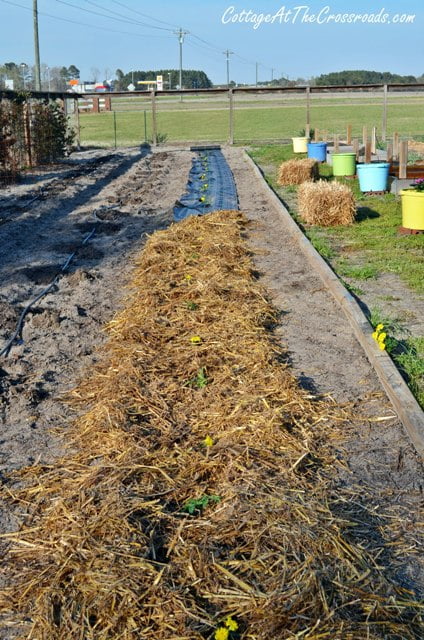
You will want to mulch around your plants to help retain moisture. We use wheat straw.
So far, we've planted about 50 tomato plants. Why so many? You can read about why in my post i've been canning tomatoes. And if you follow most of our tips about planting tomatoes, I'll guarantee that you'll be enjoying a fresh 'mater sandwich before you know it!

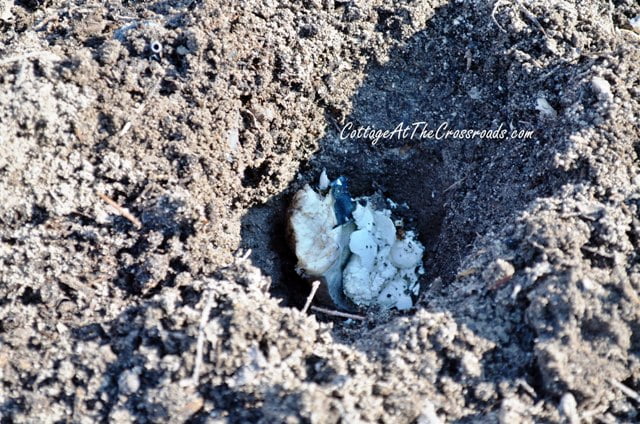
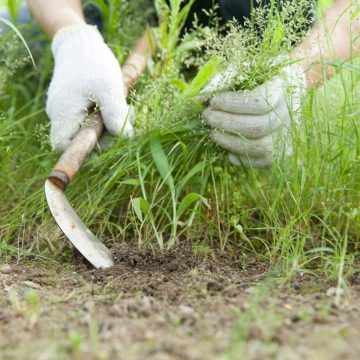
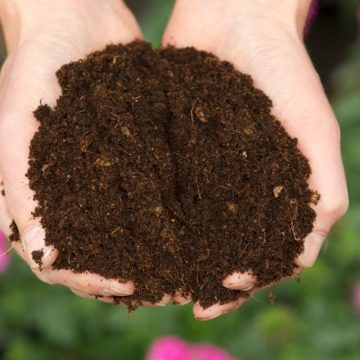
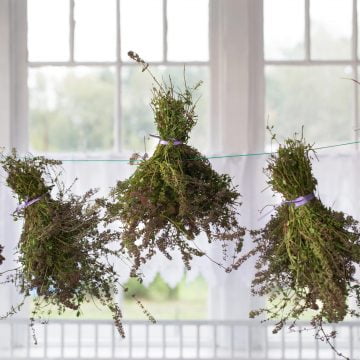
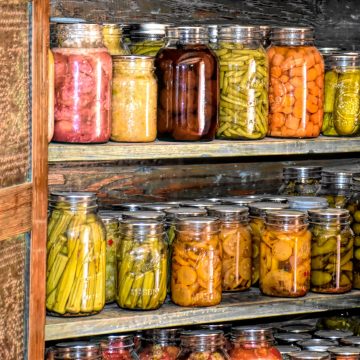
pauka
why wheat straw on top of the fabric?
Steven
Thank you for the great article. I got few young tomato plants in pots and I placed newspaper as mulching barrier on the soil. Do you think regular landscape fabric is a better choice as a mulching? Will it be an issue with watering?
Jane Windham
The newspaper will work for a short while but the landscaping fabric will last much longer. You will still get a few weeds that will come up when you make cuts in the fabric. Funny how those weeds will find a spot to get through!
Michelle
Great tips! This article helped me greatly, thank you!
Higenyi Herbert
All your tips are okay, but about 🍅 diseases and prevention. because here in Africa-Uganda we face wilt,& other viral diseases.
Jane Windham
Oh, we face so many of those diseases here, too! That's why we always plant some disease resistant varieties to assure that we will get some tomatoes!
MaryAlice Grinder
With the fish - are you putting it in raw or cooked? THanks so much - luckily I live in warm environs and am putting tomatoes out now that I had already sprouted from seed! Appreciate your experiences!
Jane Windham
We use raw fish that have been frozen. We thaw them enough to separate them and then put them in the hole. We cover them with a bit of dirt and have never had any problems with animals digging them up. If you have raccoons, though, you may have a problem.
Laura
What a great article! thank you for the info. what first brought me to this site was the eggshells. One of our older relatives told us to put eggshells in with our tomato plants and I wondered why.
This year we had a great crop and I think its because my husband used some spare plywood to make a kind of wall behind the plants. It is often very cool and windy here (in Alberta) and doesn't get that hot so the tomatoes seem to love the warmer 'micro-clime'. Anyway, i am making sauce for canning and look forward to trying out your suggestions for next year's plants. I love homegrown tomatoes!
Sensible Gardening
Found this very helpful, I don't always have the best of luck with tomatoes.
Patti
Wow, that's some garden. You must get loads of tomatoes. Great tips too.
jane
We have planted tomatoes for years usually no problem.
This year we planted our tomatoes up on boards supported by concrete blocks. In large oblong planters.
This was because we both have a back problem. We would not have to bend over to have our garden. We used only the very best soil, which had the fertilizer in it. The soil was fresh but packaged. We have watered, we have done all we could to have a good crop of tomatoes.
We are heartbroken as we have some type of rusty looking infestation on the leaves of the tomatoes!
Just about all of the tomato plants have this problem.
We use soapy water to ward off infestations. This did not help with the rusty looking leaves. They just turn more yellow and then wilt.
It is too late to pull up all the plants as most of the tomato plants in the garden centers are bought or look really sad!
We live in Michigan near Detroit. Any advice that would help us would be appreciated!
Julia
Here in France we have a new recipe for 2 years which gives spectacular results against the mildew, manure garlic and Pascal Clerc's sweet bay, for it you need 15 cloves of garlic peeled and split in two to throw in 5 liters water which has shivers beforehand and to leave will mass 4 days (the potion has to foam) then to infuse 50 gr of bay leaves wipes (fresh) in 2 liters of hot water during 12 hours in the 5th day to filter the whole and to put as it stands without dilution (pure) in an atomizer and handle quite your plants even those who are not reached. To bring back an experience one of them even crossed the stalk of a plant of tomato atteind of the mildew in the brush with this manure every day he said that the task cleared up and has to stop the disease.
Hope.
Julia
emily willingham
Epsom salts will prevent blossom end rot as well - just sprinkle around the plants and scratch it into the soil
SheilaG @ Plum Doodles
Great information, Jane. We don't do much gardening, but have planted a few tomatoes now & then. I think we did everything wrong! I'll be pinning this for future reference. A 'mater sandwich sounds wonderful! 🙂
Anita
I have seen all of the tips before. I have tried the fish in Florida. Not sure if it's going to work. We won't see them til June and will probably rotting on the vine. We have to come north each spring. And we are new to gardening in Florida. Any ways I wanted to give you another tip. I once dated a man who would add Epsom salts to the ground around the tomatoes. Said it would add magnesium to the soil. Which he thought or was told helped the tomatoes. It was a long time ago. I know it didn't hurt them but I can't remember if it made a difference in the harvest. I guess a fun fact. 🙂
Kathy
My mother always had great luck gardening. She just used fertilizer, 10-10-10, and everything produced amazingly! I guess the fertilizer had everything needed.
Thanks for the tips.
Shanno@A Cozy Place Called Home
That's a good question you asked me, where HAVE you been? I stopped blogging thinking it would be permanent but I missed all my friends and several convinced me to come back. I'm glad I did! Most of my old friends have found me again. I am glad you did too! You and Leo will be busy planting that huge garden but it is obvious the two of you enjoy gardening and what a great reward you will have when those tomatoes get ripe!! Great to hear from you, now don't be a stranger as we say in these parts. Shannon
Pat Powell
We have always had a problem w/bottom rot. Never knew what caused it. But after reading your post, understand what we were doing wrong. Need to try the drip irrigation system. Thanks for your help.
Shirley@Housepitality Designs
Wow...those are great tips Jane...never knew about the eggshells...Looks like you should have a great crop of tomatoes!!...Have a great weekend!!
Ann
I've been a dismal failure at growing tomatoes. I don't think I have enough sun and I needed to prepare my soil better. The watering thing is hard too. I never knew if I was watering too much or not enough. Last summer I threw in the towel and bought tomatoes at our local farm stands! I might try again this year...maybe! Have a wonderful weekend ~ Ann
Eileen
Thanks for the tips on the eggshells and pinching off the bottom leaves. I did not know about either of these things. As we are getting ready to plant our tomatoes, I will employ both of these ideas.
LindaLee
Thank you so much for this post. We used to have loads of tomato plants when we lived in NH. They would be over six feet tall and we would always be giving tomatoes away. Down here in NC, we've had a real hard time getting them to grow and produce. We're in eastern Norh Carolina. We'll be giving it another try this year. We bought Better Boys.
Melanie
Great tips! Just forwarded to two folks.
Mary
Great tips Jane! I didn't know about the egg shells darn it, I could have been saving them in preparation! I'll pass on the fish 🙂 We only plant 5 heirloom varieties which have lots of flavor but won't win any beauty contests. I can't imagine 50 plants~ Happy Growing!
Paul Tremel
To introduce calcium you should distribute bone meal around your tomato plants. Also be careful with fish if you have Racoons in your neighborhood. Keep fish in a bucket and bury deep. If you lay fish on ground while digging holes or you will lead animals to your plants.
Jane Windham
Thanks for leaving your tips, Paul. Bone meal is a great suggestion for people who don't save their eggshells or don't want to mess with dead fish! You're right about the raccoons. We haven't had a problem with them, perhaps because we have an outdoor cat.
Michelle
I will be showing this to my husband. Great tips, I will be using them all. I love the fish one. I don't have any in the freezer so my husband will have to go fishing. Bet that will break his heart. NOT!
Carol
Well, wish we had known about cutting off those lower leaves and planting the tomatoes at that level, but ours have been in the ground for a week now. We have learned that we have to add compost and do a lot of tilling, because we have clay -- makes things more difficult. We had a very good crop last year and the garden patch is much better this year. Thanks for sharing your expertise.
Carol
deb
Thanks so much for all the info!!!